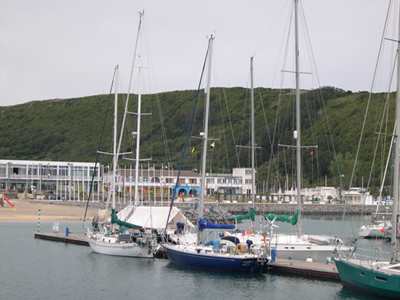Graciosa and return to Terceira

Amoret
Sun 21 Jun 2009 18:24
|
Last Monday (15 June) we finally managed to escape
from the sailing traditions of Horta and headed off past the west end of Sao
Jorge towards Graciosa. Conditions were light so we motor-sailed the entire 54
M. Our information from the latest update to Anne Hammick's "Atlantic
Islands" cruising guide was that the only feasible port, Vila da Praia, had
a new inner harbour that was restricted to local fishing boats, so we should
anchor in the outer harbour.
 As we approached, we realised that a workboat and a
dory were doing interesting things (probably laying ground tackle for local
moorings) in the area where we wished to anchor. One of the guys on these boats
told us to go into the inner harbour, so we took a peek through the narrow
entrance, saw that three yachts were in there, stooged around while we sorted
the warps and fenders, then went in to discover two long pontoons with fingers
and a fairly narrow passage between them.
 We picked up a vacant berth and, in the absence of
any official in the marina, went to the nearby office of the GNR (equivalent of
the Gendarmerie or Guardia Civil) who always require a check-in. Liv had noticed
that the berth had a number stencilled on it, so I asked the GNR officer if it
was OK to moor there. He said that was fine and completed the check-in
paperwork. Shortly after our return to Amoret we noticed the arrival of a
fishing-boat with the same number on its hull, evidently not pleased by finding
a yacht in his berth. Fortunately he seemed annoyed with the GNR rather than us
and allowed us to use his berth for the two nights we needed. We left a
thank-you bottle of decent wine in his boat when we
departed.
Graciosa is the second-smallest of the nine islands of the Azores,and probably is one of the most laid-back. Everyone says hallo (or at least bom dia or boa tarde), traffic is almost non-existent, and the local specialities are very good white wine and small sweet tarts called queijadas (though queijo - cheese - isn't one of the ingredients). We had dinner in a restaurant in the back of a cafe - excellent food and a very pleasant atmosphere, though as is often the case the menu was aspirational, listing what they might ideally hope to have rather than what was available. We went for alcatra (a stew of, on this occasion, fish), then took up an invitation for after-dinner drinks from Phil and Diane, a couple from Colorado. They had a pretty small (27ft) cruiser, which evidently sailed OK but didn't run to refinements like a galley. Understandably they showed enthusiasm at our invitation to a roast chicken dinner the following evening. That went very well, with much animated discussion of sailing, the world and its troubles. An enjoyable evening from which we parted on good terms! The best day out on Graciosa (an island about the size of Alderney) is to
walk up the volcanic cone, through a tunnel in the side of the crater, then down
to the lowest point.
 This proved to be a lovely walk with great views, an abundance of flowers
and forest, and a good climax in a very steep spiral staircase that leads
to the bottom of the Furna de Enxofre (sulphur cave), a huge cavern at the
bottom of a narrow shaft, with a small lake and holes containing boiling mud.
 After our assorted fun on Graciosa, we headed back towards Terceira at
the east end of the central group, staying this time at Praia da Vitoria on the
east end of the island. A large bay is partially enclosed by two breakwaters,
with a very pleasant town and a small, well-run marina at the north
end.
 A lot of Americans are around because Praia is next to the very long
airport runway which is shared with a major U.S. air base. This week is the
festival of SaoJoaninas (St John), but on Terceira this is a major
annual knees-up rather than a serious religious festival. We took the
bus to Angra and spent time very pleasantly in a lovely public garden listening
to a band concert, complete with bandstand and a diminutive boy playing the
triangle.
 A by-product of the large cattle population and a period of Spanish
occupation is that no festival is complete without a bullfight. These are
generally not the traditional Spanish variety but involve a bull, inadequately
restrained by a long rope with half-a-dozen men attached, being let loose on a
town square, a beach or a quay so that the local lads can display their
bravery by inciting it to charge then getting themselves out of trouble as best
they can. Such events result in no injury to the bull but frequent injuries
to the young men. We found one such event in Angra yesterday, on
the old town quay at Porto Pipas.The festive atmosphere became somewhat
subdued when the first bull fairly soon caught one of his tormentors,
knocking him down then tossing him so that he was carted off in an ambulance,
seriously hurt or worse. This was a fairly unedifying
spectacle so we decided not to stick around for further
events.
 We are now doing some "make and mend" jobs on board, with the weather
suggesting that mid-week might be a good time for a comfortable
overnight passage to Sao Miguel, the biggest island which, with Santa Maria,
forms the eastern group of the Azores.
|